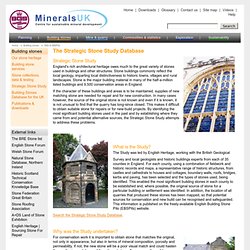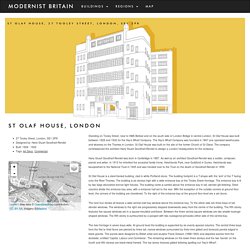

Heritage buildings, stone and masonry. Repair and refurbishment of historic buildings Effective building conservation needs to extend the life of a structure without compromising its special character.

Strategic Stone Study & Building Stone Quarries. Strategic Stone Study England's rich architectural heritage owes much to the great variety of stones used in buildings and other structures.

Stone buildings commonly reflect the local geology, imparting local distinctiveness to historic towns, villages and rural landscapes. Central School of Art and Design 07. Central School of Art and Design 47. Holland Hse, Bury St HP Berlage (1916) 01. Holland Hse, Bury St 03. Holland Hse, Bury St 08. Darwen Terracotta and Faience. St Olaf House 03. St Olaf House, Hay's Wharf. Standing on Tooley Street, near to HMS Belfast and on the south side of London Bridge in central London, St Olaf House was built between 1928 and 1932 for the Hay's Wharf Company.

The Hay's Wharf Company was founded in 1867 ane operated warehouses and wharves on the Thames in London. St Olaf House was built on the site of the former Church of St Olave. The company commissioned the architect Harry Stuart Goodhart-Rendel to design a London headquarters for the company. Harry Stuart Goodhart-Rendel was born in Cambridge in 1887. As well as an architect Goodhart-Rendel was a soldier, composer, pianist and writer.
St Olaf House is a steel-framed building, clad in white Portland stone. The next four stories all feature a wide central oriel bay window above the entrance bay. The river frontage in seven bays wide. Other notably external decoration to the building are on the Tooley Street frontage. St Olaf House now houses the London Bridge Private Hospital's consulting and administration rooms. St Olaf House 05. Fabric & energy improvements for traditional buildings. Atlas of Building Stone. This Building Stone web application allows you to access the information held within the Strategic Stone Database through a map-based interface.

Accessing the data There are several ways to access the data held within the map. Search for Building or Quarry Stones – Search for either Buildings or Quarries within Mineral Planning Authorities whose records contain data on a particular stone type. For example, search for all Stone Buildings, within Bedford Borough Council which contain Great Oolite Limestone. Left-click map feature – Clicking on a map feature, such as a building or quarry, will display a box containing information about that particular site, such as which MPA it belongs to, any alternative names, where the information was sourced from and listing any known stones recorded there.
Navigating the map To pan: left-click on the map and drag. Get feature details. Stone Federation - British Stones. Britannicus stone. Shining Stones: Britain's Native Marbles. Britain's Native 'Marbles' Graham Lott and David Smith Britain’s historic buildings can often prove to be a treasure trove for the marble enthusiast.

High status buildings like royal palaces or stately homes may have colourful marble-lined halls, grand marble staircases, or extravagantly carved fireplaces. Our cathedrals and churches can show an even more diverse use of marbles from simple memorial tablets, intricately carved tombs, pulpits, fonts, decorative columns, colourful marbled floors to loud and extravagant Victorian graveyard statements. In the 19th century marbles became decorative status symbols in the newly established banks and commercial headquarters of our major towns and cities. In the main, the marbles on view are imported varieties, a trade which has grown since Roman times. Ibstock Brick & Paver selector. Imperial Handmade Bricks. FACADES - positive side damp proofing. Alan Baxter Associates. Angle Ring - Gallery. Images opposite represent some of our work to the present date.

Please click on the pictures to view them in larger format. All images on this site are copyright of The Angle Ring Co Ltd or the photographer and must not be used without prior consent. NOTE:Images may be used for educational or business purposes, subject to our terms and conditions. Typically there is no charge for this. However, to ensure we retain control over all images, an authorised person on behalf of The Angle Ring Co Ltd must agree with any use in advance, in writing. All images are available at higher resolution or as hard copy on request. Contact Paul Middleton for further information. About Us - Curtins Consulting. We’re run by people for people “Curtins has a rich heritage that spans more than 50 years and I feel immense pride in having been a member of the team for over three decades, starting as a technician in my teenage years and becoming Chief Executive in 2004.

Since our founder Bill Curtin set up the business in 1960, we have grown from a small consultancy based in his house in Liverpool to having 13 offices across the UK and Ireland. But we remain very much one team, knowing that by working together we deliver better results. Wood Structural timber in construction CPD. Structural Timber Association. More and more house builders are beginning to appreciate the benefits of timber, with the material currently accounting for around 75% of the self-build market, as well as being widely adopted in social and private housing.

During the recession, in reaction to a downturn in the housing market, many members evolved their businesses to adapt to changing market demands. As a result, the timber industry is no longer defined simply by the supply of timber frame kits and panelised solutions.